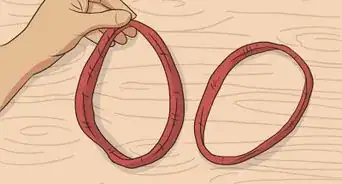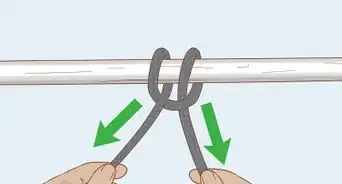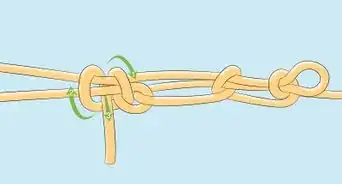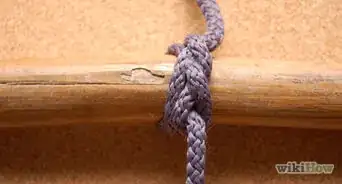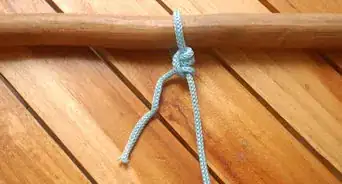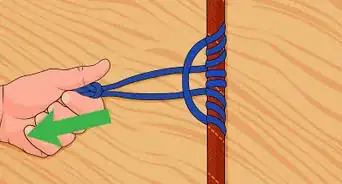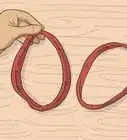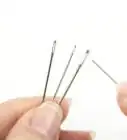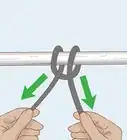This article was co-authored by Britt Edelen. Britt Edelen comes to wikiHow after graduating in 2019 from Brown University, where he studied English and German literature and philosophy. While at Brown he contributed frequently to campus publications and worked in the university’s Writing Center. More recently, he has had several articles published in various journals devoted to literary criticism. During his time at wikiHow, Britt supervised and collaborated with writers and editors to continue producing high-quality content and promote wikiHow’s mission of enabling everyone to learn anything.
This article has been viewed 317,289 times.
Quick-release knots are those that you can undo with a simple tug, and the highwayman’s hitch is perhaps the most popular one. It looks like a complicated, secure knot when it’s tied, but a quick tug and it comes completely undone. The name comes from its history as a favorite knot of highwaymen in the days of stagecoach and train robbers. However, you can use this knot for simple hitching purposes, or just for fun! Just be careful since this knot comes undone easily and don’t use it for climbing or other weight-bearing purposes.
Steps
Creating the Basic Knot
-
1Fold the rope approximately 2 ft (0.61 m) from one end to form a loop. Loops are also known as bights. Once you make the bight, place it behind the pole, post, or other object that you’ll be securing the knot around. Wrap the topmost part of the loop over or around the side of the pole or post.[1]
Tip: A bight is the word for a loop in knot-tying. Forming bights is an essential part of tying a quick-release knot.[2]
-
2Form another bight out of the rope on the right side of the first loop. This side is known as the standing end. Loop the rope just as you did before to make the first bight, but using the standing end just below the post or pole. The standing end is the side of the rope that will not release and that you’ll secure this end to whatever you’re tethering.[3]
- If you are using this knot to secure a horse, the horse would be secured to the right side of the rope and the left side would be left hanging.
Advertisement -
3Insert the new bight through the first one you made. The 2 bights or loops need to connect to start the knot. Push the bight you just made into the first one you made by bringing them towards each other around the pole or post.[4]
-
4Create a third bight with the quick-release end (working end). This is the left side of the rope. Form this bight about 6 to 12 in (15 to 30 cm) from the other 2 bights.[5]
-
5Bring the new bight through the last bight you made. Just as you did the first time, tuck your new bight into the loop of the last bight you made. Pull it through so that the rope is taut at the base of the bight.[6]
-
6Pull the standing end to tighten the hitch. This is the non-release part of the rope on the right that will be sturdy when you tug on it. Tug on this end to tighten the knot until it feels secure.[7]
-
7Untie the knot by tugging on the quick-release end. To untie or collapse the hitch, pull on the quick-release end and the knot will instantly come undone. Only do this when you are ready to untie the knot as it will undo it completely and you’ll need to retie it if you’re not through with it.[8]
Anchoring the Rope Safely
-
1Make a safety ring from baling twine if you’ll be tying up a horse or boat. If you’re using a quick-release knot to tie up a horse or boat, create a safety string around the hitching ring or post you’ll be using. Tie a 1 ft (0.30 m) piece of baling twine loosely around the object. Double knot the ends together. Then, tie your knot through the twine instead of directly to the object. This will ensure that you can easily cut the rope free if the knot gets tangled and you can’t undo it.[9]
-
2Tuck the end into a loop to prevent it from becoming undone. Some horses figure out that if they tug on the end of the rope with their teeth, they can undo the knot and free themselves. The knot may also come loose on its own if it’s not strong enough or if you accidentally tug on it. To prevent this, tuck the quick-release end of the rope into the loop at the top of the knot. This will help to secure the knot.[10]
Tip: Keep in mind that if you tug enough on the end of the rope after you insert it into the loop, it will actually tighten the knot and you may not be able to undo it as a quick-release. This is why it’s important to create a safety ring and tie the rope through that instead of directly to a post.
-
3Add an extra bight to strengthen the knot. If you want to make the highwayman's hitch more secure, add one more bight through the last loop that you made. Use the standing end (right side) of the rope to do this and then tug on the standing end of the rope to secure it.[11]
- This is similar to the tumble hitch knot, which has 3 layered bights.
-
4Avoid using the highwayman’s hitch knot for climbing purposes. If you accidentally grab the quick-release end, the knot will come completely undone and you will fall. Reserve this knot for when you only need to quickly secure something and having it come undone won’t be a hazard.[12]
- For example, you might use this knot, if you need to secure your horse for a few minutes or tie up a kayak while you get into it.
Community Q&A
-
QuestionShould I use this knot when tying a horse to a fence or something similar, or should I use a different type of knot?
 Lord of the SlothsCommunity AnswerThis knot could be used for this purpose, but consider using the more stable Tumble Hitch.
Lord of the SlothsCommunity AnswerThis knot could be used for this purpose, but consider using the more stable Tumble Hitch. -
QuestionHow do you take the knot out?
 EquestriangooseTop AnswererPull the running end or tail. That is the end of the rope that isn't attached to what you are tying up.
EquestriangooseTop AnswererPull the running end or tail. That is the end of the rope that isn't attached to what you are tying up.
Warnings
- Never leave a horse tied up unattended.⧼thumbs_response⧽
- Watch out for potential hazards, such as uneven ground or holes, when choosing a tethering place for a horse.⧼thumbs_response⧽
- Only tie up a horse at the level of their withers to sturdy posts and fences. Never tie a horse to something they could move, such as a gate, or to something that’s higher up than their withers.[13]⧼thumbs_response⧽
Things You'll Need
- A rope
- A pole, post, or other sturdy location to tie the knot onto
- Baling twine (optional)
- Knife (optional)
References
- ↑ https://www.animatedknots.com/highwaymans-hitch-knot
- ↑ https://www.almanac.com/content/how-tie-knots
- ↑ https://www.youtube.com/watch?v=oz8fKzvN_UU&feature=youtu.be&t=30
- ↑ https://www.youtube.com/watch?v=oz8fKzvN_UU&feature=youtu.be&t=32
- ↑ https://www.animatedknots.com/highwaymans-hitch-knot
- ↑ https://www.animatedknots.com/highwaymans-hitch-knot
- ↑ https://www.animatedknots.com/highwaymans-hitch-knot
- ↑ https://www.animatedknots.com/highwaymans-hitch-knot
- ↑ https://www.horsejournals.com/horse-care/illness-injury/prevention/how-tie-quick-release-knot
-Step-2-Version-4.webp)
-Step-4-Version-4.webp)
-Step-11-Version-2.webp)
